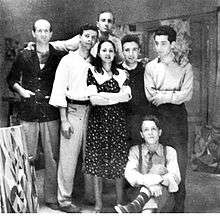Piero Dorazio
Piero Dorazio (June 29, 1927 - May 17, 2005) was an Italian painter, whose work was related to Color field, Lyrical Abstraction and other forms of abstract art.

Biography
He was born in Rome and died in Perugia. His father was a civil servant, but his mother had interests in history and art. Dorazio attended the Julius Caesar lyceum in Rome as a young man. In 1943, the family fled to the Abruzzo, the family's home region. Dorazio worked briefly as a translator for the British army. After the war, he then took some courses in architecture in Rome.[1]
But soon, he gravitated to painting, influenced by futurists such as Gino Severini, Antonio Corpora, Enrico Prampolini, and Giacomo Balla, but averse to the fascist background of many futurists, aligning himself with more left-leaning artists like Renato Guttuso.[2] Along with Pietro Consagra, Achille Perille, and Giulio Turcato, in 1947 he belonged and helped formulate a manifesto by a group of abstract artists called Forma I. While imbued with the socialist leanings, this group, influenced by the abstractions of the Futurism movement, he did not follow the realist social commentary furthered by Guttuso. In 1947, he won a stipend from the French government to study at the École des Beaux-Arts of Paris.[3]
In 1950, Dorazio helped found L'Age d'Or, an artists' cooperative gallery, to exhibit abstract works. In 1952 promoted with Burri, Colla and others the foundation Origine and edited the magazine Arti Visive. In 1955 he published "La Fantasia Dell-Arte Nella Vita Moderna," a review of Modern art in Italy. In this book, reviewer Christopher Masters states, Dorazio advanced his belief, perhaps with surfeit of optimism, that: abstract art could change the world.. that just as science and technology were destroying the barriers between different cultures, so the new "universal style" would lead to a "universal civilisation".[4]
In 1953-1954, he traveled to the United States at taught with a summer program at Harvard University. In 1961, he was awarded the Prix Kandinsky.[5] In 1961-1969, he taught in the Department of Fine Arts at the University of Pennsylvania School of Design. In 1970 he returned to live and work in Todi, Umbria.[6] He continued to exhibit until at least 2003.
Described as an outspoken, independent character who was the opposite of politically correct, Dorazio's use of materials and colors did not shift much over time. He is known for many paintings rich in color, highlighting thick bands of bright color, often cross-hatched grids.[7] While abstract, they do not neglect detail or complexity. The style is allied to what was later described as "Post-painterly abstraction" by Clement Greenberg.
Exhibitions including his work
Among the exhibitions that have included or featured Dorazio:[8][9][10]
- 1952 Venice Biennale
- 1960 Venice Biennale
- Wittenborn One-Wall Gallery in New York in 1953.
- 1965, "The Responsive Eye", Retrospective, Museum of Modern Art, New York
- 1970s, André Emmerich Gallery
- 1979, Retrospective, Musée d'Art Moderne de la Ville, Paris
- 1980, Albright-Knox Art Gallery in Buffalo.
- 1990, Grenoble
- 1991, Bologna GAM
References
- ↑ Piero Dorazio: Italian painter inspired by the revolutionary power of abstract art. Obituary, by Christopher Masters for The Guardian, 26 May 2005.
- ↑ Obituary by C. Masters for The Guardian in 2006.
- ↑ Ken Johnson May 2005 Obituary in Art and Design section of New Yor Times.
- ↑ Obituary by C. Masters for The Guardian in 2006.
- ↑ Catalogue of the Tate Gallery's Collection of Modern Art other than Works by British Artists, by Ronald Alley, Tate Gallery and Sotheby Parke-Bernet, London 1981, p.175.
- ↑ Ken Johnson May 2005 Obituary in Art and Design section of New York Times.
- ↑ Obituary by C. Masters for The Guardian in 2006.
- ↑ Ken Johnson, Obituary for NYT, 2006.
- ↑ Dizionario Larousse della pittura italiana: dalle origini ai nostri giorni, Artist biography edited by Marina Sennato, page 168-169.
- ↑ Catalogue of the Tate Gallery's Collection of Modern Art other than Works by British Artists, by Ronald Alley, 1981.